More Innovation:
CENGN Summit 2020 in a Snapshot
CENGN Summit 2020 was CENGN’s first-ever virtual Summit. Thanks to the intensive planning, expert speakers, innovative showcase participants, and supportive sponsors, the day was a success. As CENGN’s CEO JC Fahmy noted, “Data is now the currency” in this growing digital economy. Many other speakers shared this notion, highlighting the rapid development of technology and Canada’s next steps towards continued innovative growth.
The Tech showcase allowed tech companies to highlight their solutions and upcoming projects. CENGN also released a new services video and announced the Students of the Year, business student Anna Maystruk and technical student Chibuike Onuiqwe.
The speakers at CENGN Summit 2020 discussed essential and relevant topics trending in technology right now. The focus of conversation hovered around the digital economy and the ICT industry’s growth, the increased demand for edge computing, more robust security, and cloud accessibility for all.
Read some highlights of what our speakers had to say:
The Digital World
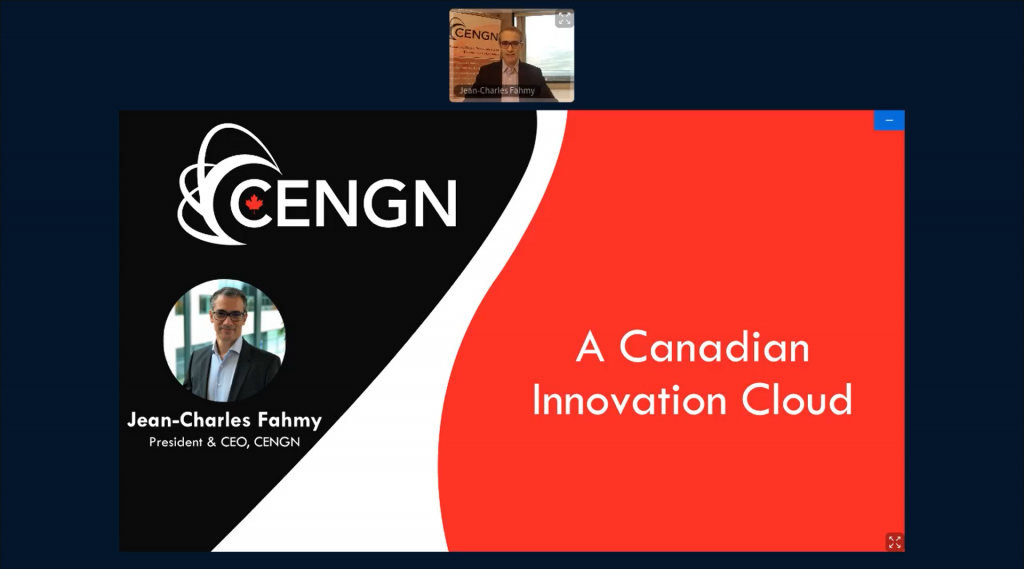
In 2019, Canada’s ICT sector market size totalled 210 Billion, growing rapidly over the past decade. JC Fahmy listed the technological pillars driving future innovation as infrastructure security, AIOps and distributed cloud networks. In a closing statement, JC presented his vision to accelerate Canada’s digital transformation through a CENGN operated nation-wide hybrid cloud infrastructure.
“Today, the ecosystem is too siloed, and we have the opportunity to work collaboratively to accelerate the Canadian ecosystem. With this [innovation cloud], we’re only limited by our imagination.”
Pascal Menzes, CTO of MEF, highlighted the digital economy’s growth, leading to the reliance on the network edge for faster service. Menzes noted, “People want to be connected in a frictionless environment,” and highlighted that we must use automation to deliver this frictionless experience. The rise of digital service providers and the need for automated edge services have grown thanks to automated carrier ethernet & IP services, SD-WAN services, and security services.
John Graham-Cumming, CTO of Cloudflare and Lindsay Sill, COO Quantum Algorithms Institute, discussed how changes in the current business landscape are leading to new technology requirements. In 200 cities worldwide, Cloudflare has an extensive global network of capacity and hardware. Being directly in cities, the edge is utilized to deliver a faster, more secure internet experience to the end-user. Graham-Cumming notes, “COVID has accelerated the move from in-office private firewalls to the need for secure internet connections.”
Cloud Native
(Powered by CANARIE)
Kicking off our first technical track themed “Cloud Native”, BluWave-ai’s Director of Engineering, Hubert Sugeng, offered some lessons learned by a startup with a cloud native architecture. Here are a few tips from Hubert:
- QuickStart isn’t that quick (there’s a lot of often overlooked steps!)
- Use Kubernetes.
- Isitio helps with service discovery and training tools.
- Helm is a great tool to manage deployments (easy upgrade and rollback path)
- Wasting memory is the number one driver of cost.
- Cloud-Native Software needs upgrades often; consider maintenance plans.
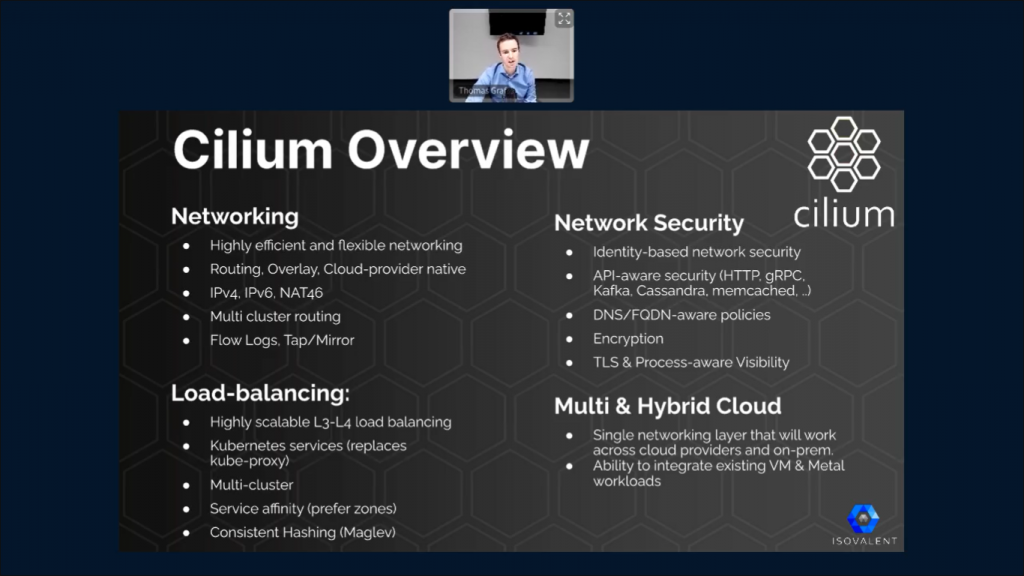
Cloudical’s Alexander Trost discussed the importance of using proper storage tools on your cloud applications. Container Storage Interface (CSI) is a standardized interface that easily provides application storage. Kubernetes reads storage claims, talks to the CSI interface and distributes storage to applications. ROOK is an operator in Kubernetes that automates processes using custom resource definitions (CRDs). This allows the creation of custom objects in Kubernetes. ROOK runs Ceph and other storage so that users can consume storage and manage cluster storage. Trost notes that “Without a cloud provider, storage can be a pain.”
Thomas Graf, CTO of Isovalent, examined the future of software networking and the impact of open source project, Cilium. We’ve moved from hardware networking to software-defined networking and now cloud-native networking. Cilium and eBPF accelerated the evolution of networks. Cilium makes the networking layer application ware by utilizing eBPF. Cilium’s programmability allows the network to be completely decoupled from security and visibility layers. Graf believes that the future will bring more eBPF load balancing at the edge and a single networking layer to serve all clouds “Designed for the Kubernetes and cloud-native age.”
Open RAN and its Effect on the Mobile Ecosystem
The Open RAN panel consisted of Amdocs Director of Technology, Alla Goldner, Parallel Wireless’s VP Sales, Steve Libbey, CEO of Core Analysis Inc, Patrick Lopez and CTO, IDB/MOEA, Howard Tsao. They explained that Open RAN consists of taking software elements and opening the interface, so they’re based on open standards and APIs. This means that you can now mix and match hardware and software from different vendors. Open RAN is not just for 5G either; it supports all network generations, making it relevant for more than just urban centres.
Libbey observed that capital expenses and operating expenses are critical drivers of Open RAN. Goldner agreed, noting that the standardized interface opens the market for smaller vendors. Tsao added that when more of these small vendors enter, costs decrease even more. Lopez noted that Open RAN allows vendor lock avoidance but must be easily deployable and operable.
The panel agreed operators can expect total cost savings of 30-40% by implementing Open RAN. Goldner pointed out machine learning capabilities using Open RAN didn’t exist before, and the network is now much more flexible than ever. Open RAN has opened the door for technology use cases we haven’t even heard of yet.
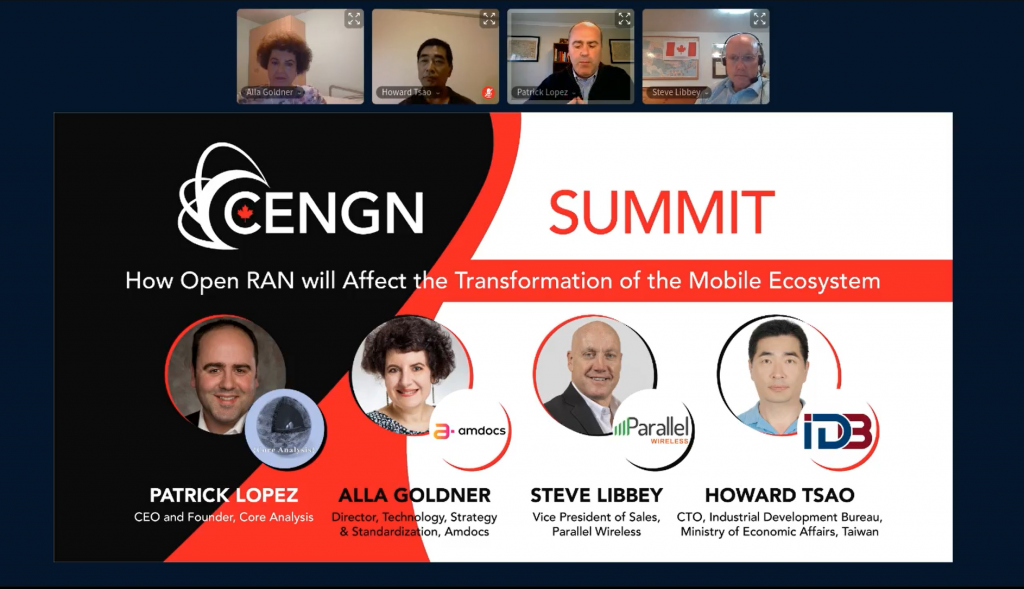
Canada’s Wireless Industry: Key Enabler for Canada’s Economic Recovery
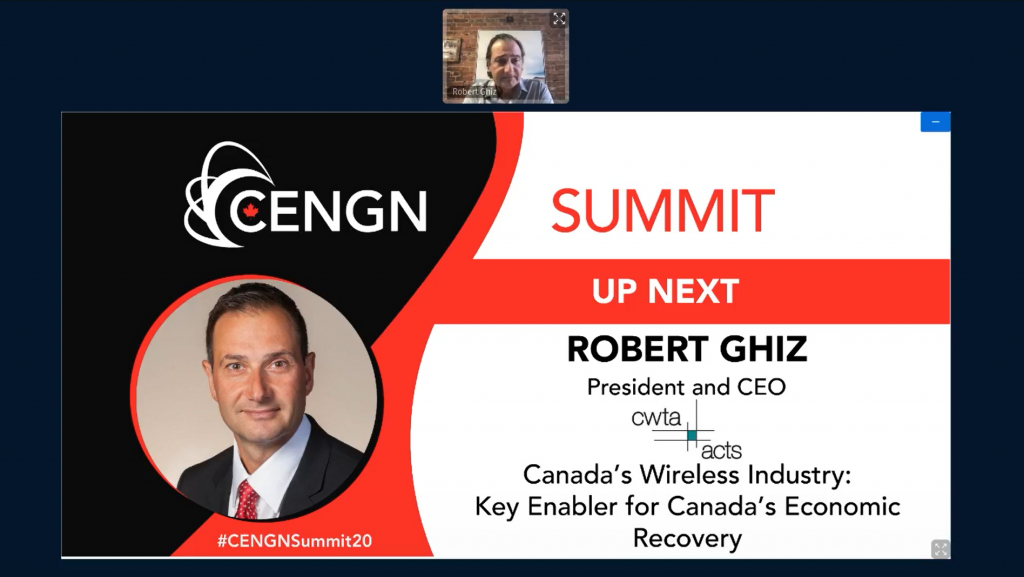
Robert Ghiz is President and CEO of CWTA. He outlined how Canada’s wireless industry has kept Canadians connected during the pandemic. Robert has seen an increased reliance on wireless connectivity and in response, wireless companies have waived data usage and roaming fees to help combat those affected.
Earlier this year, Open Signal Analytics Company called Canada a “4G LTE Powerhouse”. It announced that in 2020, Canadians enjoy the fastest download speeds in the world. Ghiz claims the adoption of 5G will do wonders for our country, he stated that 5G will create an estimated 250K full-time jobs by 2026, and 5G enabled technologies can address 23% of Canada’s total emission reduction targets by 2025.
To fully utilize the potential of 5G, Canada needs to adopt a stable regulatory environment. Ghiz notes that to be successful, support is required from the Canadian Radio and Telecommunications Commission to encourage investment to enable growth and innovation.
Cyber Security
(Powered by ORION)

To start our “Cyber Security” themed track, Director of Network Infrastructure and Operations, Robert Eveleigh and Network Security Solutions Engineer Arka Ghosh of ORION outlined the severity of malicious Distributed Denial-of-Service (DDoS) attacks. Globally, DDoS attacks are growing larger, shorter in duration, and are becoming more complex. Eveleigh highlighted the importance of complexity growth by showing that since 2017 there’s been a 2851% increase in DDoS attacks with 15+ vectors. This growing complexity means that attacks are getting harder to detect and stop. To defend against this, ORION’s platform uses present-day protocols combined with automation to mitigate DDoS attacks. This automated solution allows a reduced timeframe for detecting and countering dangerous DDoS attacks.
Boris Mimeur, CENGN’s VP of Engineering Operations and Research Ambassador of MANRS, noted that globally, we’re more connected and reliant on the internet than ever before. As of November 2020, 70,000 public networks exist across the world, forming the internet. Each of these 70,000 networks use an autonomous system number (ASN) to identify itself to other servers. With this global network, security is crucial. Routers use Broad Gateway Protocol (BGP) to exchange reachability information, detecting and mitigating hijacks. But, Mimeur points to the 2008 YouTube Hijack to outline the potential global impact security incidents can have.
“To tackle global security issues, we need a collective effort,” Mimeur says as he introduced MANRS- Mutually Agreed Norms for Routing Security. MANRS’s goal is to improve the global internet routing system’s security and reliability through mentorship and guidance from the routing security community.
Nicolas Thomas, SDN/APIs strategist at Fortinet, outlined how essential security is. The move to digital security providers and SD-WAN opens new territory for global service providers to obtain full protection. This SD-WAN security as a service concept is crucial to support growing network edge demands.
Thomas said we should have a vendor-neutral, formal definition of security functions that apply generically to security services. To provide advanced security to the end customer efficiently, we need improved encryption methods, such as the middlebox function (MBF) to decrypt and re-encrypt TLS sessions. This allows the deployment of advanced security functions on clear traffic, such as URL Filtering and Malware Detection and Removal. Moving forward, Thomas says the focus needs to remain on SASE, security at the edge, and Zero Trust security.
Preparing for Digital Transformation
Our innovation track, Preparing for Digital Transformation, dove into the nuances between network technology advancement and its implementation in industry and the marketplace. The segment began with Avent VP of IoT, Lou Lutostanski, who shed light upon the “Internet of Things goldrush” and its transformative impact. He says that cloud connectivity has now given us access to data around the world. The cloud collects and stores data from different IoT sensors, whether that be traffic speeds or weather conditions. To go further, the cloud then needs software applications to visualize and apply AI to gain insights and generate predictive analytics. This function, Lutostanski notes, would “Allow a nimble business model where you know what happens to your customers or products in real-time.” Since no company can perform all IoT applications, the future involves an IoT ecosystem to streamline implementation and scalability. Having this defined ecosystem allows people to participate in IoT solutions at scale efficiently.
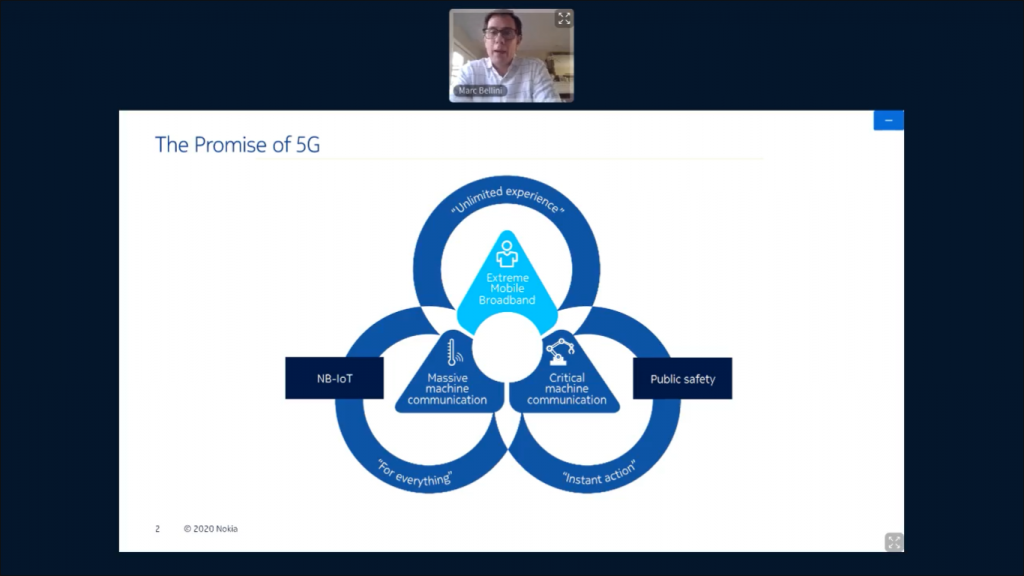
Marc Bellini, VP technology at Nokia, outlined the promising future that 5G networks will bring to Canada. He stated that our current 4G networks are maxed out, and 5G brings the promise of mass high-speed communication. 5G is not only beneficial but critical for Canada’s communication demands. 5G will bring us a plethora of life-enhancing products and services. To maximize resource use, 5G network slices need to be dynamic and need complex orchestration. This can be realized with automation, leveraging AI and ML to analyze network functionality. These smart networks will understand needs and distribute useful APIs.
As Bellini stated, “5G needs more than just cloud”, with DevOps bringing the opportunity for dynamic cloud evolution. An end to end distributed cloud will drive a new way to look at how networks are deployed. Coming together for scaling purposes, public and private clouds allow applications to run closer to the customer in a container-based architecture.
Canadian Sales Manager for Nvidia, Eric Dahan, introduced how computing has changed over time. For application-specific computing, GPU computing has taken over, being used by 40% of the top 500 supercomputers. By mastering AI, ML and now deep learning, we have effectively imitated how the human brain functions and makes decisions. This growth of data drives advanced networking needs. Edge computing now utilizes AI resources which need to be continuously retrained to perform inference at the edge. Optimizing AI at the edge will enable enhanced IoT and smart cities around the world.
Past and Future: The Evolution of the Network
Zayo’s EVP Lit Solutions, Hannah Wanderer, discussed the network’s evolution alongside JC Fahmy. Zayo deploys fibre for some of the world’s largest bandwidth consumers and is the largest independent infrastructure provider in the US, Canada & Western Europe. Wanderer points out that larger bits of bandwidth are being requested as well as additional security to protect against DDoS attacks since the start of COVID-19. In reaction, Zayo is now offering scalable security solutions directly to the edge.
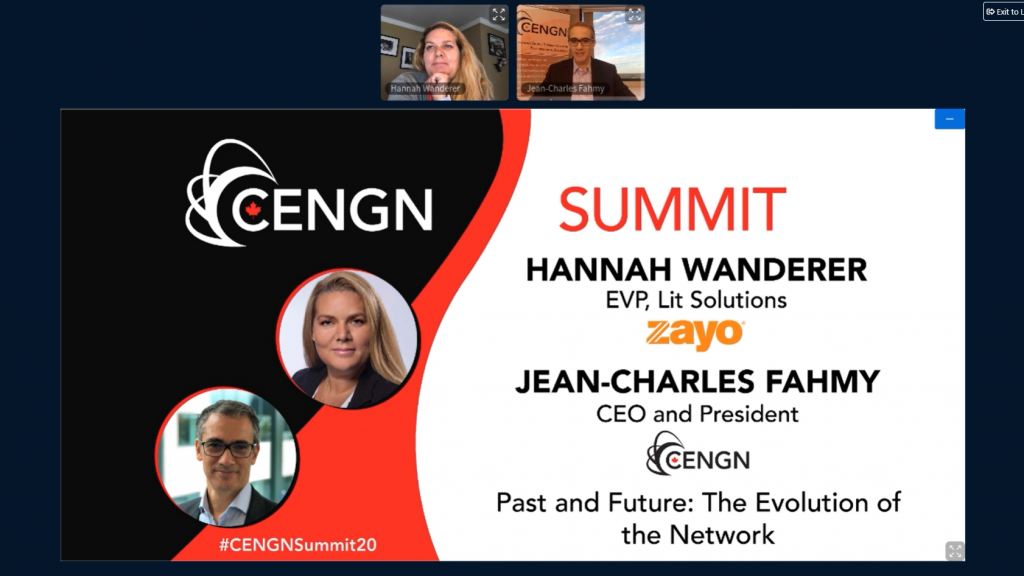
Zayo is a cloud-first company, which unlike non-cloud-first companies, transitioned well to working from home this year. Wanderer noted that cloud transitions need to be easy, and providers must offer a seamless experience. Related to 5G, Wanderer sees more remote networks for employees and customers, drone landing stations, and fibre stations for efficient offloading. This increased bandwidth is changing how operators and businesses are utilizing fibre in their locations. In the future, Zayo is looking into how to handle the increased demand in traffic and drive towards the edge.
The entire day highlighted the opportunity for even more innovation in technology as we advance. We see the evolution of 5G bringing new promises of connection and speed that must be supported by the correct infrastructure. CENGN has and will continue to be a leader in technological innovation and support technology growth in Canada.
The common thread of the day was that the digital world is continuing to grow rapidly. To keep pace, we must work together on common standards and processes to streamline efficient growth for all. CENGN is excited to see where one more year of growth will bring us and can’t wait to see you all at CENGN Summit 2021!
CENGN Summit Sponsors
CENGN would like to thank our sponsors for their generosity and support for this year’s Summit.
Platinum: CWTA
Other Sponsors: University of Ottawa, Carleton University, ORION, KRP Properties









